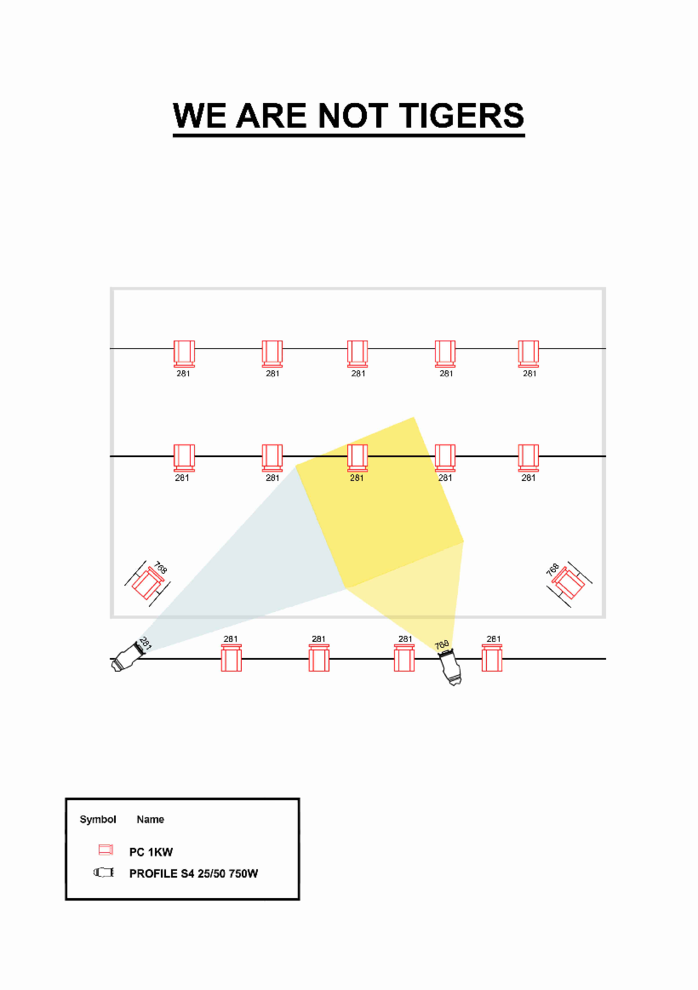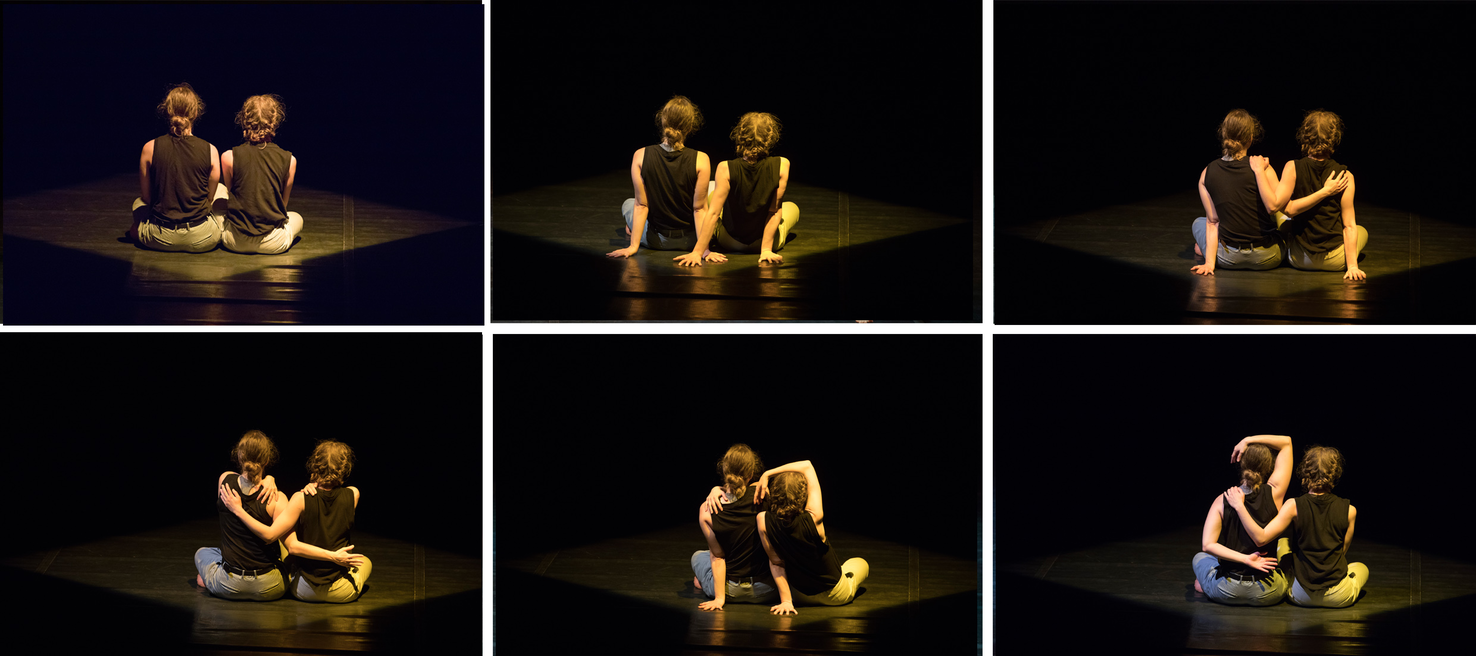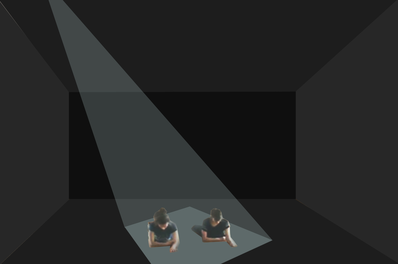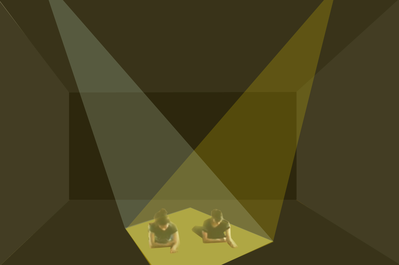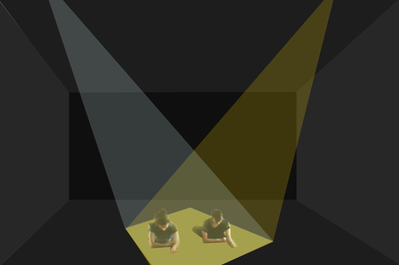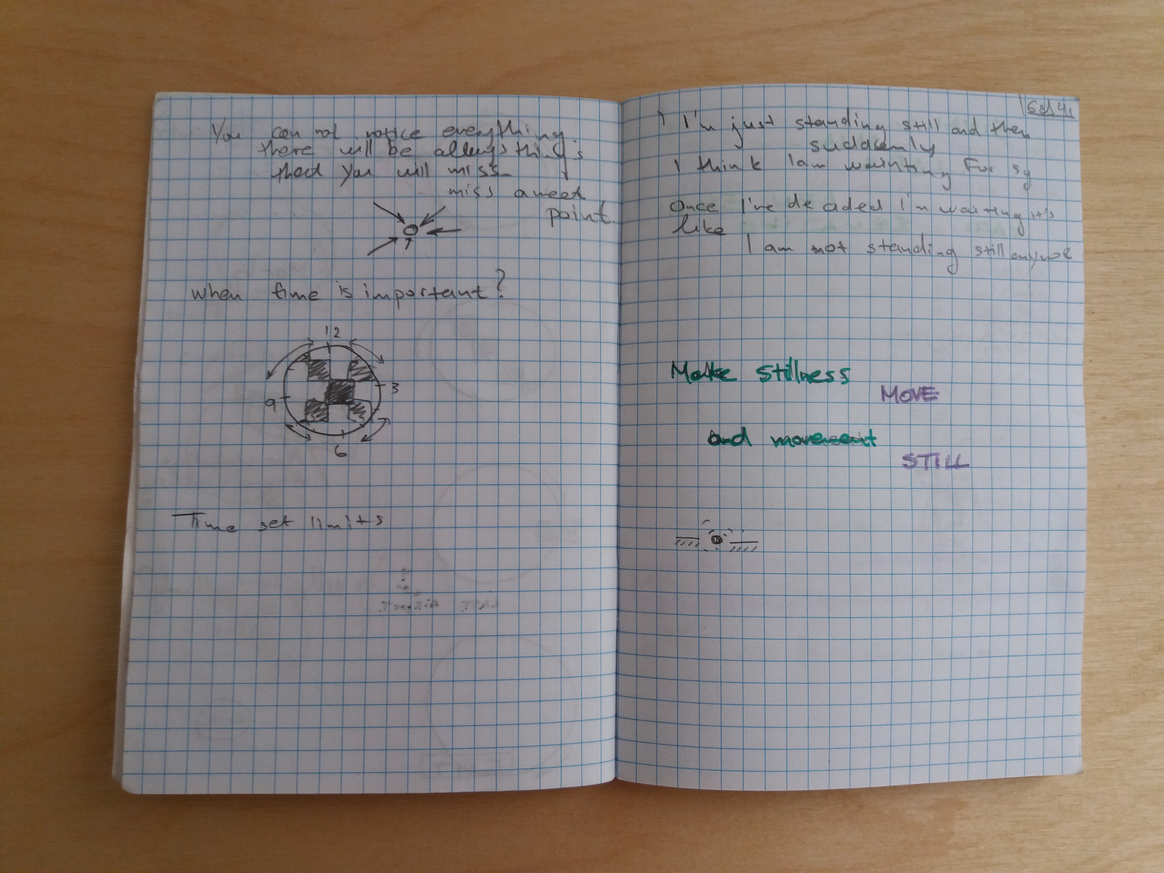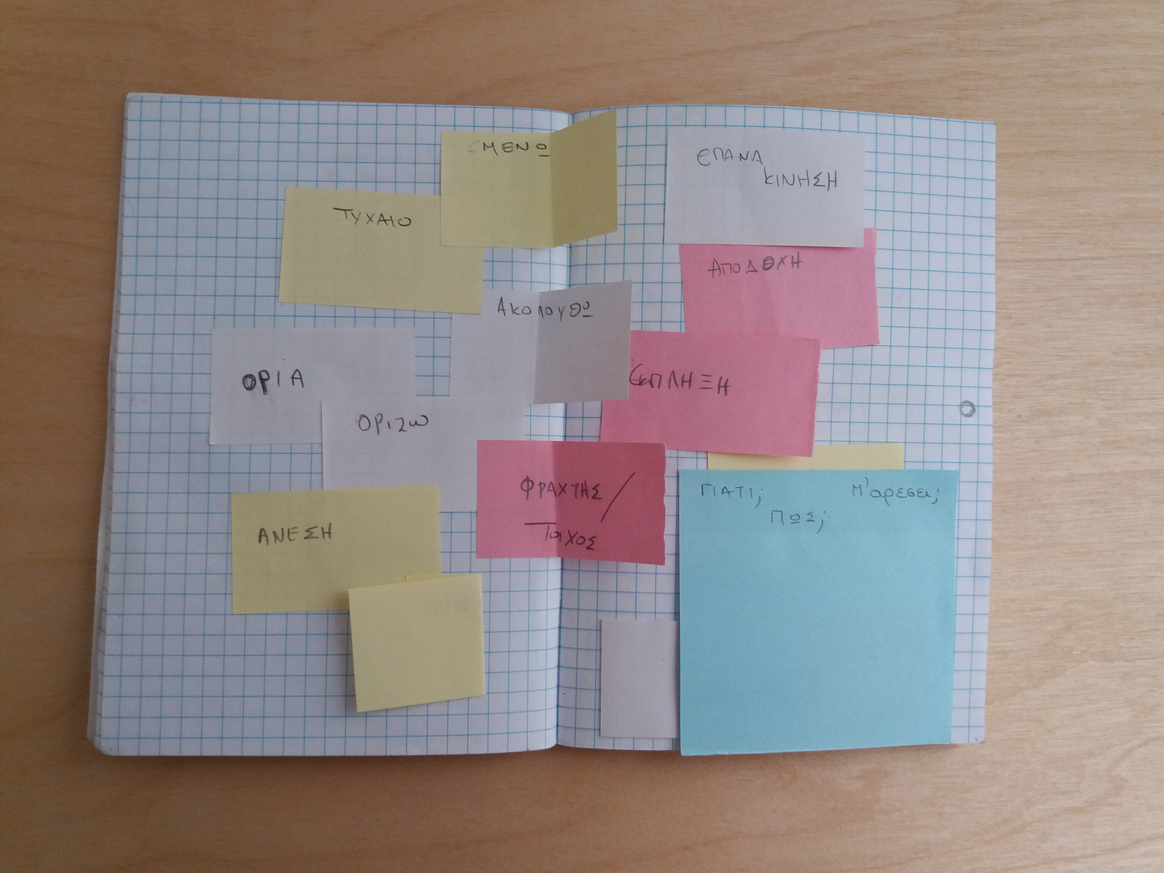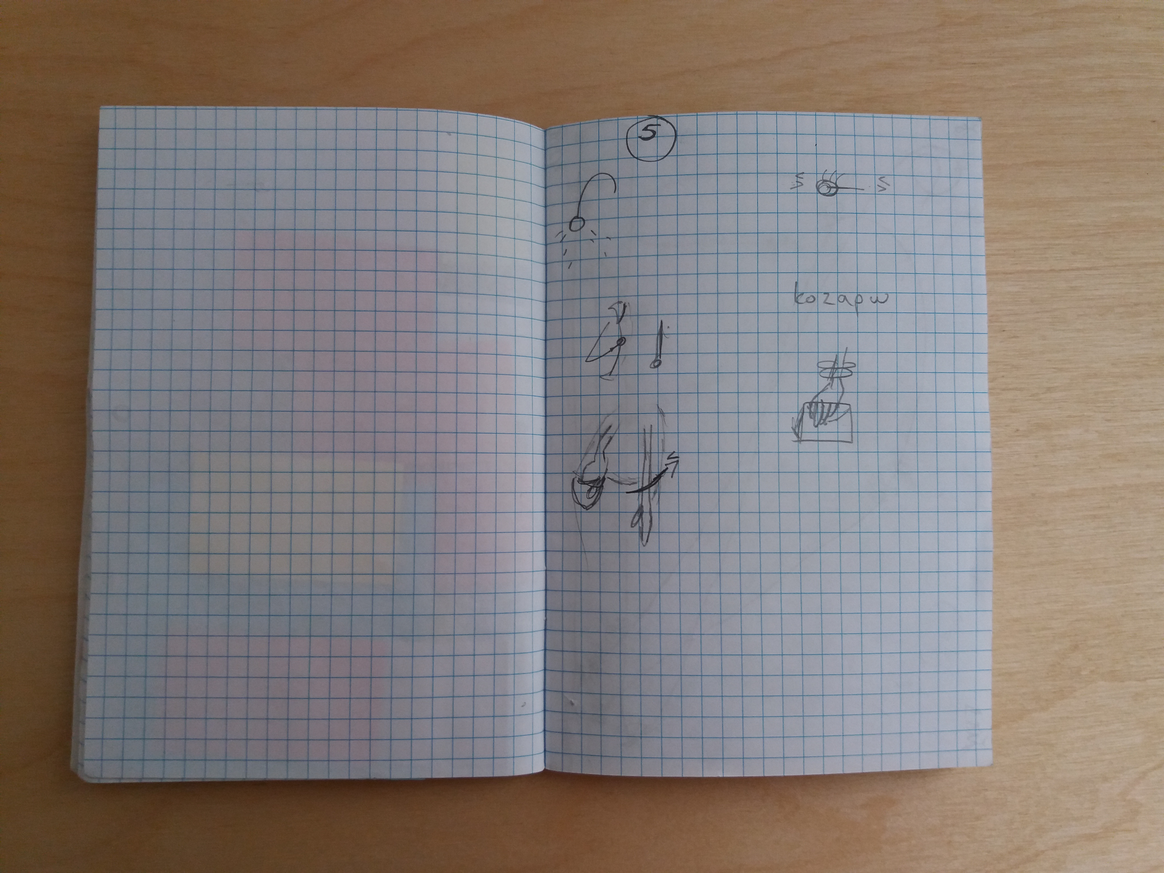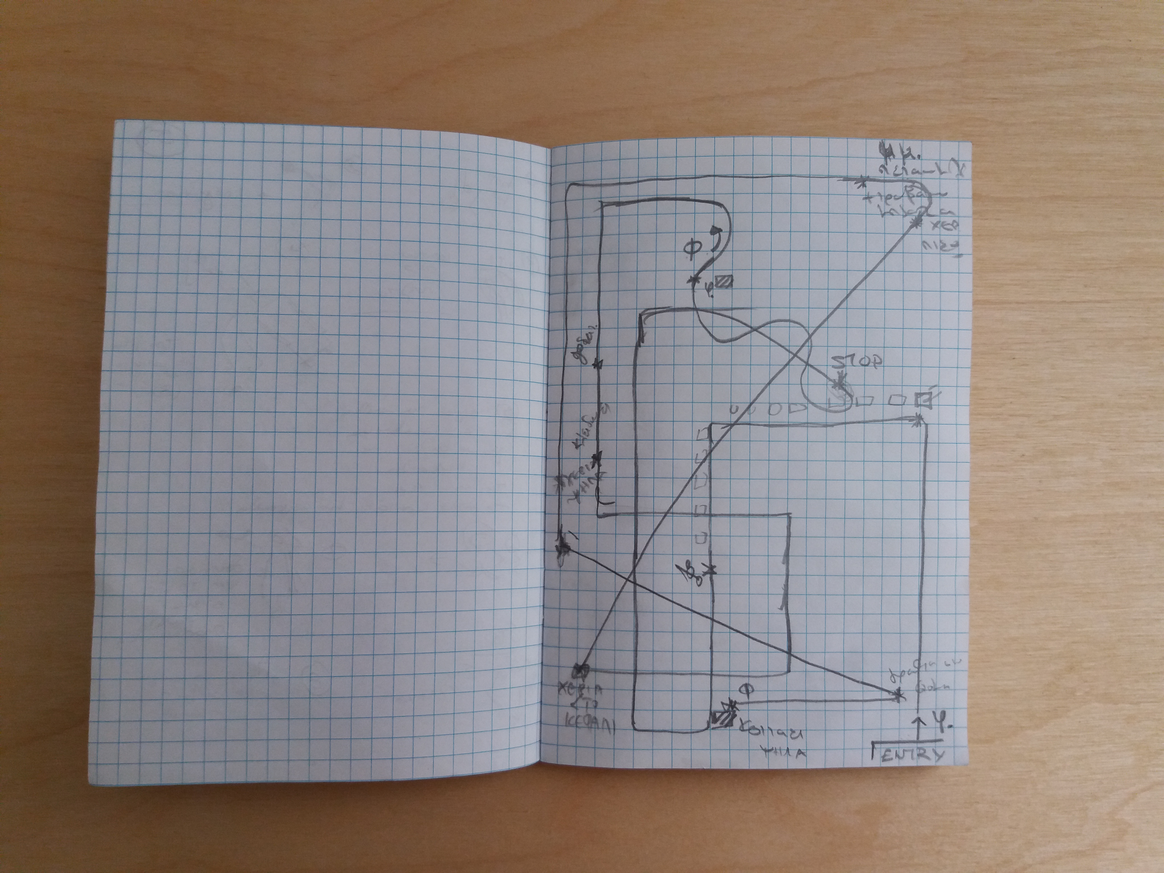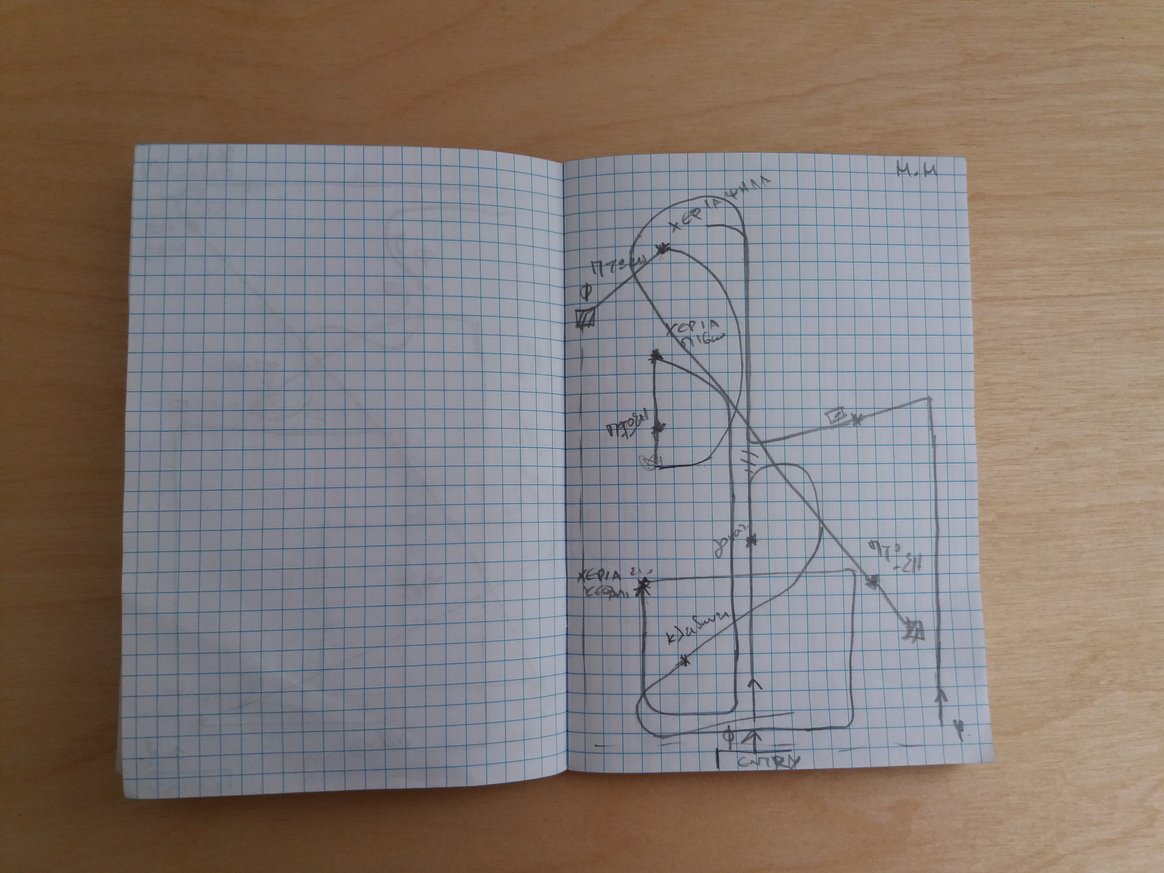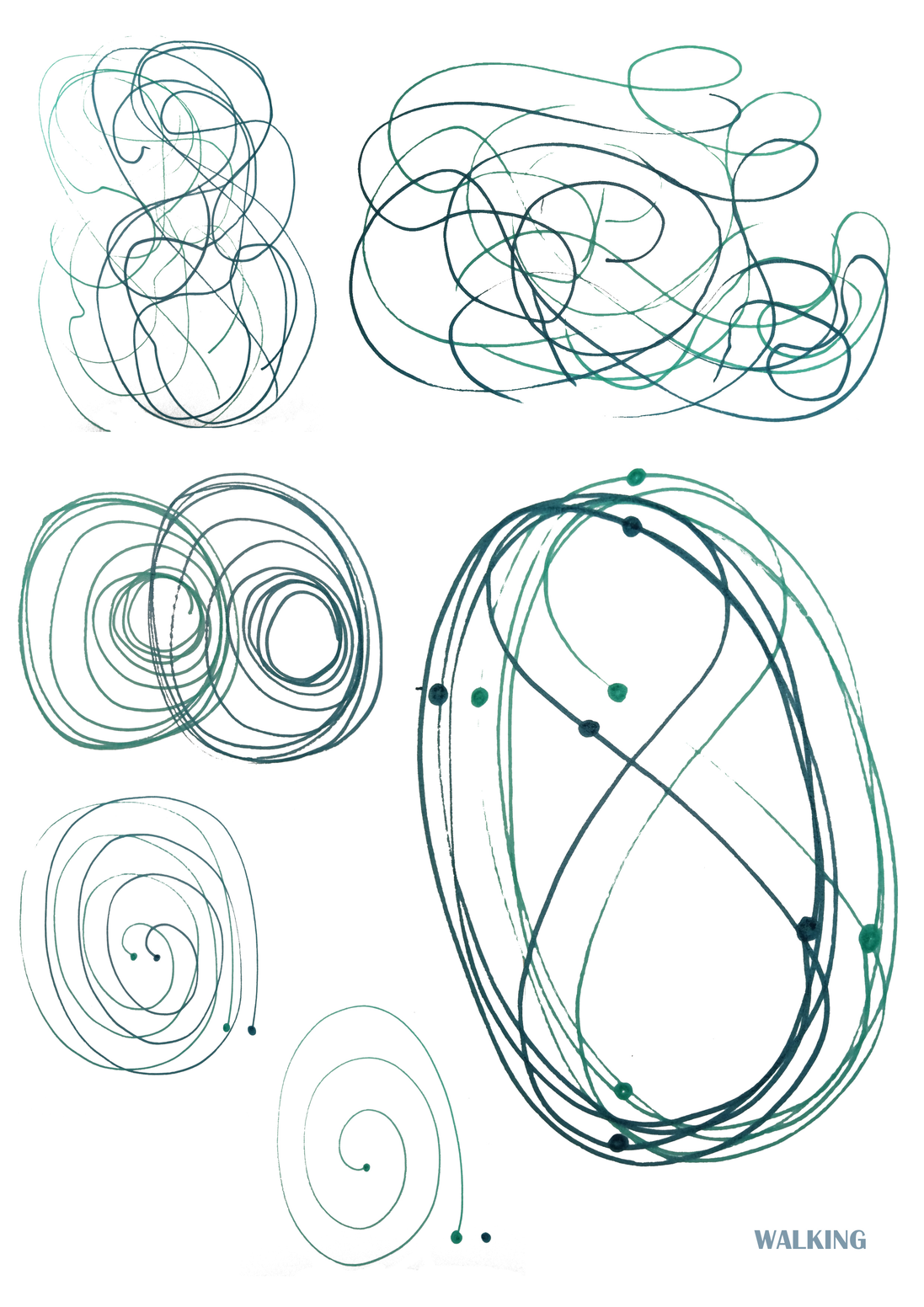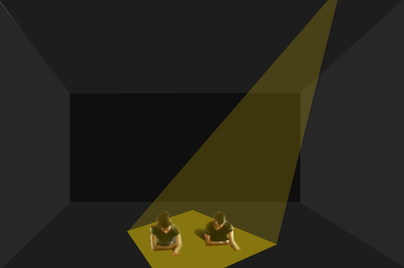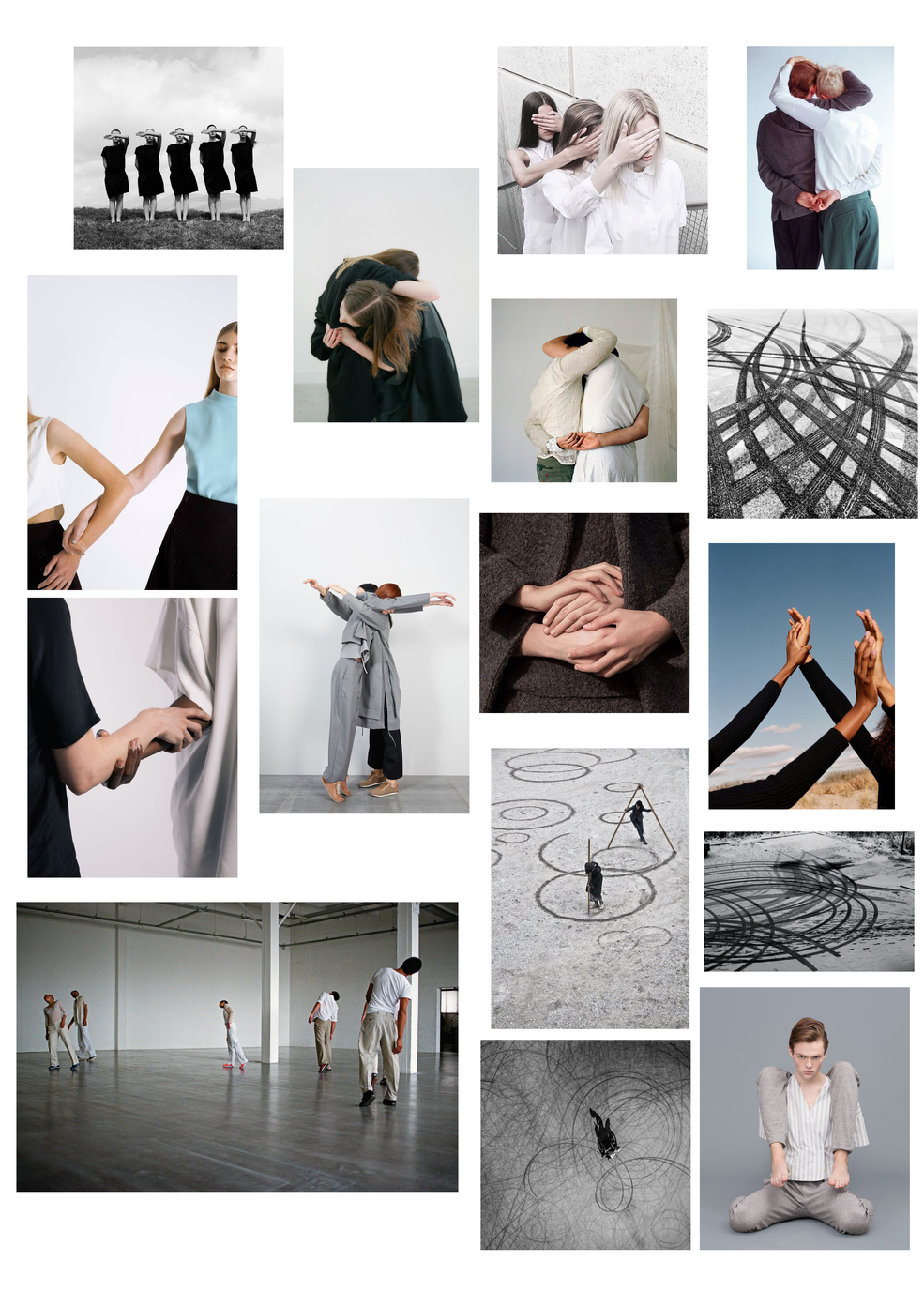REHEARSAL NOTES
1.
Logistics – trying to figure out a schedule. We realize it is not possible to find more than 2 mornings in a week to work together… We decide to keep it like that for now and add more when possible. We look at the general schedule until July.
Warm up
Walking
- Tuning our pace together
- Passing through – walking in a curved track, I always try to pass between the other two.
- Parallel tracks – keeping our directions parallel while walking
Gesture motive
I show a sequence of gestures to do while walking parallel tracks – one is ‘leading’ the other is arranging the distance, keeping parallel to the other
After the break, I briefly introduce the development of the research since the last time we worked together in November and we discuss ideas of personal space.
Personal space / intimate space
- Introducing the concept – what it means / how it feels to move in each one.
- Approaching personal space
- Attacking personal space
- Reaching out from my personal space to meet the other
- Moving together – I want to enter the other’s space – I want to keep her away from my space
*I still need to make the tasks more clear – make more clear what I am looking for.
2.
Warm up
Walking tracks
- parallel tracks with speed variations – how fast can we maintain the parallel?
** can I find a way to trace the tracks on the ground?
Gesture motive
- working on a motive that can be done while walking
- Using text I gathered through writing prompts of observing the street
- Observing gestures -> noting gestures -> embodying gestures
Personal space – no time to work on it today
Homework
- Work on the motive
- What is my intimate/private space
** make an archive of gestures
3.
Warm up
- moving and trying to keep in my perception the space behind me
- suspending in space and catching / not catching myself
Tracks
- speed / rhythm
- change of dynamics
- magnets – attraction / repulsion ** not done
Personal space
- one enters – the other readjust to avoid her
- softly / aggressively ** not done
- move always connected on one spot – change dynamics
Motive
- elaborating
- changing shapes & directions
- rhythm
- qualities
What we did instead:
Suspension duet – one fall – one supports
Meetings – creating shapes in counterbalance – figuring out ways to resolve and meet again
TO TRY
- one falls – one supports
- more assymetrical
- how to document gestures
- written exercises?
4.
Warm up
We started with the same warm up as yesterday – moving and suspending in space, keeping in mind also the space behind.
Falling duet
- one moves, the other supports her
- how to develop this? ** could be a scene?
- When her pelvis touches the ground, immediately change the role
- Gradually speed up the falling
- A sequence of falls as a transition
Meetings
- Walking in a circle in opposite directions - fixed meeting points
- What happens in the meeting point?
- Tasks with specific body parts: left / right hand, nose / back
TO TRY
- ** could this work with a rope? –try to catch her rope
- Meeting in different points in the circle – different speeds
- Maybe the circles are already traced on the ground?
Tracks
- Crescento – build up the pace
- Gestures in the upper body and arms
5.
Warm up
Walking
- Work on our presence when walking
- Crescento
- Little hiccups – small changes in the pacing of the feet
- Build up a motive
*How to make this work? It didn’t work at all at took up most of our time and energy…
Falling duet
Meetings
- The meetings out of balance should start with pulling – not falling towards each other – it becomes too much of a hug
- Keep up the energy / speed up
- More asymmetry
Not touching duet - game
-stand at arm length distance and try to touch the other without been touched
6.
Meetings
- Try different tracks
- More real / more dynamics
Gestures
- come back to the gestures motive
- add dynamics
Catch me if you can
- work a not-touching duet as a game
- can I make this performative without losing playfulness?
**Thankfully today things work better, compared to yesterday… I decided that instead of trying out all the ideas first, maybe it is better to work on the basic ones in order to gain more confidence in the material (all three of us).
7.
Falling alone
Falling and supporting
without arms
one fixed in space falling
the other going around supporting
walking and falling in parallel tracks
combine walking with the falling duet
Faidra brought in some thoughts and a score to try out
How to make movement still and stillness move
Final score
8.
Gesture motive – complexity / flow
Track – complexity
Duet 2 in 1
Walking – 5 spots and finding a way to release the gesture
Gesture motive – make it bigger within the body and in the space – 3dimensionally
Duet 2 in 1 – could be a finale?
Meetings – why do they meet?
Maybe too much circling around makes the viewer dizzy?
Music – music – music
I need to start fixing the soundscape
9.
Work on the duet
Try a somatic approach – moving from the center outwards – one touches – the other ‘grows’ from the part where she is touched
A sensation from the inside growing outwards
- orientation in space
- in the body
Shadow duet
Music – fade out when the duets are happning – or more dynamic sound?
Sound – everyday sounds processed
Repetition?
Exhaustion?
we are not tigers
10.
Duet – growing at the point of touch – experiment alone – add the idea of little fallings
What it means to dance too close – one in front the other following very close
How to add more dynamics?
Your dancing self – too close
Echo
On all fours – fists for feet – tigers
Letting things develop long enough and the tigers appeared
Fix it in a solo with a clear route in space
Put it in the duet
Mind map
11.
- a vocabulary of observed gestures
- a walking track with those
- a way to come together (not there yet)
Daily observations as a ritual
Each one fixes a route with her gestures
Walking – with the metronome
Duet (tomorrow)
12.
Observing the street
- crossed kisses
- hands that talk: open – cross – open – cross
- body in front – head to the side
- one hand holds the other which holds the mobile phone
- holds a notebook – opens – stops – reads – lifts head – searches – walks
- runs 3 steps backwards – changes track again
- stands still – the skirt winds
- runs – kind of clumsy
- runs – loosely – looks down
- round arms – shoulder to ear
- head that searches with the eyes
- Hands in pockets
- Hand wipes the eyebrow
- Stretch back and roll (dog)
- Hand – looks at woatch
- Hand – arranges hair – pats lightly down the front part of the head – head lowers a little
- Finger points – soft hand on the chest – loose elbow
Observation to paper to movement
Track
Walking on the peat (112 bpm)
The motives become more fragmented
Make it faster – transition to a duet ?
It is all a matter of rhythms
13.
1. microgestures – only the tracks without pause
2. 5 spots on the track
3. small motives
Large motives interrupted
Large motives in flow
Acceleration
Intimacy duet – εξέλιξη
Start with softness impro – one touching the other moving
Work again the duet one in front of the other (faidra asked)
Clean the walking and motives – accelerate – sudden fall?
Work on the walking track and the beat – 114
--- what happened? How to deal with this? Did something happen? I am not sure but I feel tense – how to release it?
14.
A - without pause
5 x 2 – the second time without empty circle
B – small motives
C – small and large motives
Fall – slowuly down – transition to sitting
Transition
PAUSE FOR EASTER BREAK AND BLOCK F
WE ARE NOT TIGERS is an attempt to talk about
the everyday, or, ‘about what happens when nothing
happens, but time, people, cars and clouds.’ (Perec, 1975)
The research is inspired by the writings and working
methods of French writer Georges Perec, notably his
approach on space and everyday life and the way he
transcribed those into his creative processes and
eventually into his writing.
The piece develops in two scenes:
In the first scene, the two dancers create parallel walking paths on stage, performing a series of gestural phrases, which become more intricate as time passes. Their task and challenge is to ‘stay together’, in an anyway impossible parallelism. The soundscape of recorded city sounds supports the intention to create a city on stage. In the second scene, a passage to a more intimate space is depicted, where the two dancers come closer together and tune together in a more subtle, intrinsic way.
The idea of ‘everydayness’ as constantly escaping definition is supported throughout the piece by the dancers’ non-performed presence and the fluidity of the gesture.
The title of the piece is inspired by a quote from a lecture on proxemics by anthropologist Tim Stock: ‘A tiger’s personal space is 30 feet. We are not tigers.’ In the context of the piece and in relation to the title of my complementary research project I DON’T SEE DEER, this title resonated with me, as it subtly references to humankind, through abstraction.
Light design
The lighting design by Eliza Alexandropoulou reflects the idea of ‘a walk in the city, in the course of 24 hours’. Starting with a bright stage (day light), the light slowly lowers in order to create shadows and blur the details. Transitioning into the second scene, the light becomes yellow (night light) and a closed, internal space is created through a precise shape, which later dissolves again.
BRIEF GLOSSARY – concepts, tools and methods
Attempt – an essay, a trial, an experiment, an assay
In Perec’s writings, the essay as a type of text, attempts to link the personal with the universal, to talk about a common issue by placing it into context and through the individual lens of the writer. Perec’s essays go beyond the usual formats and intersect with other modes of writing: lists, indexes, diary entries as well as ethnographic and geographical descriptions (Phillips, 2016). His essays become collections of fragments of insights and ideas with no specific intention of delivering conclusions.
The everyday
‘The everyday escapes, that is its definition.’ (Maurice Blanchot, 1969)
‘What is really happening, what we live through, what happens every day and recurs every day: the banal, the quotidian, the obvious, the common, the ordinary, the infraordinary, the background noise, the habitual.’ (Georges Perec, 1973)
Walking
Walking is arguably the most basic form of movement in public space, which occurs daily and mostly unconsciously. Through walking we form a primarily bodily relationship with the urban space: It is through walking that we experience and interact with the urban environment in ways sensorial and reflective at the same time. (Vroman & Lagrange, 2017).
Walking was for me the main tool to connect the stage piece to the public space. I find that walking offers the potential to create new spaces on an empty stage and to refer to the pathways of a city grid.
Observation
a: an act of recognizing and noting a fact or occurrence often involving measurement with instruments
b : a record or description so obtained
Also, force yourself to look more flatly.
Observation has been a main tool for movement research. We experimented with different ways of observing and documenting movement, and then with ways of transcribing those through studio improvisations.
Gesture
Gesture is experience that does not require verbal explanation (Noland, 2009).
Also,
All gestures are incomplete and have no meaning, until they integrate touch (Gill, 2012).
Through observation of movement in the street, we gathered an extensive repertoire of gestures that were then set on different walking tracks. The notion of gesture as touch was explored in conjunction with the concept of intimate space.
Sound design
The soundscape was created in collaboration with Italian composer Alessandro Bartolena. For the first scene, he created a street soundscape, in order to support the notion of creating an abstract city on stage. Although the idea of a city soundscape for the walking scene was already in my mind, in the rehearsal process, the piece was created independently from music or sound. We created the walking scene mostly in silence, or experimenting with sounds and a metronome. This way, the dancers do not depend to the support of sound in order to tune in together.
The second scene was also developed before the music was composed. Bartolena’s composition supports the idea of an intimate space, by creating a minimalistic, fluid melody that slightly refers to an underwater sensation.
REFERENCES
Gill, S., (2012), Dancing Culture Religion, Lanham, MD: Lexington Books.
Noland, C., (2009), Agency and Embodiment: Performing Gestures/Producing Culture, Cambridge: Harvard University Press.
Perec, G. (1973). Species of spaces and other pieces. (J. Sturrock, Trans.). London: Penguin.
Phillips, R. (2016). Georges Perec’s experimental fieldwork; Perecquian fieldwork. Social & Cultural Geography,19(2), 171-191.
Vroman, L., & Lagrange, T., (2017), Human movement in Public spaces: The use and development of motion-oriented design strategies, The Design Journal
Notes from a talk with Iris Karayan
How is the theory embodied?
Start from the piece itself, look at it. What it is? What it has?
Look at it closely, in choreographic terms. Then see how I can connect it with the theory.
A relationship / a duo
A mechanism is created, something that functions constantly and gradually the main theme appears.
How do we see the images / how does the viewer see the images
What am I trying to see through the body – what does the experience of the body offer me
How can I communicate better with the dancers
What is the intention of their movement – what are they thinking – it could be something purely kinetic
Look at the movement itself – the intention of the movement
Look clearly at the parts of the piece – without the theoretical concepts
What happens? What do I want to happen?
Where does it come from? How can I see something? Something that I see and try to find out what it is?
The speed – the beat of the body
The walking – the breathing
I create a mechanism
Intimacy is rendered in a fragile, subtle way
What are the characteristics – shades of grey
Other morphological characteristics?
My aim is not to please everybody
What kind of world do I want to create?
What is my idea? What do I present eventually? What it is – what it has.
The distance between them – the walking – the perpetual path in space
Where does it come from – what does it give me
The gestures – tryouts from different directions
The distance – how do I talk about the distance
How do I work the distance?
What I see – what is there in the piece – how do I see it as a viewer – what do I guide the viewer to see
How do I design the space and the image that the viewer sees
Take a risk – choose where I want to focus, 1-2 things and look at those more deeply
How can I go more deeply into something, like in theory?
